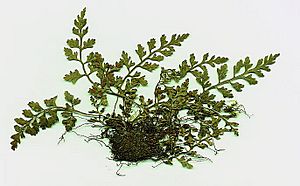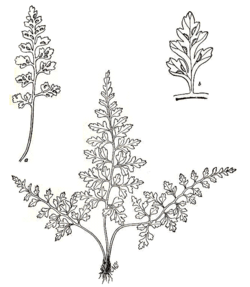Mountain spleenwort facts for kids
Quick facts for kids Mountain spleenwort |
|
|---|---|
 |
|
| Conservation status | |
| Scientific classification | |
| Genus: |
Asplenium
|
| Species: |
montanum
|
| Synonyms | |
|
|
The Asplenium montanum, also known as the mountain spleenwort, is a small fern. It grows naturally in the eastern United States. You can mostly find it in the Appalachian Mountains, stretching from Vermont all the way to Alabama. Some smaller groups also live in the Ozarks and the Ohio Valley.
This fern loves to grow in tiny cracks in sandstone cliffs. The soil in these cracks is very acidic. Often, the mountain spleenwort is the only plant that can live in such a tough spot! You can spot it by its bunches of dark blue-green leaves, which are split into many small parts. A botanist named Carl Ludwig Willdenow first described this plant in 1810.
Contents
What Does It Look Like?
The mountain spleenwort is a small fern that stays green all year. It grows in clumps. Its leaves are a pretty bluish-green and are deeply divided. They grow from a long stalk that often hangs down. All the leaves look the same, whether they are fertile (can make spores) or sterile (cannot make spores).
The fern has underground stems called rhizomes. These are about 1 millimeter wide and can curve upwards. They don't branch out much. However, new plants can grow from the tips of the roots, making it look like there are many stems close together. These rhizomes are covered in dark brown, pointy scales.
The main stalk of the leaf, called the stipe, is dark brown to purplish-black and shiny at its base. As it goes up towards the leaf blade, it turns dull green. This stalk is usually 2 to 11 centimeters long. It is thin and breaks easily.
The leaf blade itself is thick, smooth, and a dark blue-green color. The middle part of the leaf, called the rachis, is dull green with a few tiny hairs. The leaf blade is shaped like a triangle or a spear, with a flat or slightly rounded bottom and a pointed top. It can be 2 to 11 centimeters long and 1 to 7 centimeters wide. Sometimes it can be as wide as 10 centimeters.
The leaf is cut into many smaller parts. It has four to ten pairs of widely spaced sections called pinnae. Each pinna is triangular or spear-shaped. Its edges are deeply cut into even smaller parts called pinnules or deep lobes. The veins inside the leaf do not form a net-like pattern and are hard to see.
On fertile leaves, you can find 1 to 15 oval-shaped spore cases, called sori, on the underside of each pinna. These sori are about 0.5 to 1.5 millimeters long. They are covered by clear, pale tan covers called indusia, which have slightly jagged edges. Each spore case holds 64 spores. The mountain spleenwort has 72 chromosomes in its sporophyte stage. This means it is a diploid plant.
How to Identify It
You can tell A. montanum apart from other ferns by its dark bluish-green color and its widely spaced, deeply cut pinnae.
- Bradley's spleenwort (A. bradleyi) has pinnae that are toothed and not as deeply cut. Also, the dark color of its stalk continues partway up the main leaf axis.
- Wall-rue (A. ruta-muraria) has a green stalk, and its pinnae have longer stems and are widest near the tip.
- Wherry's spleenwort (A. × wherryi) is a mix of Bradley's spleenwort and mountain spleenwort. Its leaf blade is more spear-shaped, not triangular, and its upper parts are not as deeply cut. The dark color of its stalk also extends further up.
Fern Family Tree
This fern was first thought to be the black spleenwort (Asplenium adiantum-nigrum) by André Michaux in 1803. But in 1810, Carl Ludwig Willdenow realized it was a different species and named it Asplenium montanum.
Later, some scientists tried to put it into different fern groups, but these changes were not widely accepted. Today, most experts agree it belongs to the Asplenium genus.
A big study of Asplenium ferns in 2020 showed that A. montanum is part of a group called the "Onopteris subclade." Ferns in this group are usually small and grow on hillsides, often hiding among rocks in open areas. Its closest relatives are A. onopteris and A. adiantum-nigrum.
Different Forms
In 1974, Timothy Reeves found an unusual group of A. montanum ferns in the Shawangunk Mountains. He found that these ferns had yellow-green leaves, shorter fronds that were very deeply cut all the way to the tip, and all their fronds were sterile (could not make spores). He called this special form Asplenium montanum forma shawangunkense.
Hybrids and Relatives
The mountain spleenwort often creates hybrids with other ferns in a group called the "Appalachian Asplenium complex." This means they can mix their genes to create new types of ferns.
For example, in 1936, Edgar T. Wherry figured out that Trudell's spleenwort (A. × trudellii) was a hybrid between A. montanum and lobed spleenwort (A. pinnatifidum).
Later, in the 1950s, Herb Wagner did more studies. He suggested that Bradley's spleenwort (A. bradleyi) might be a hybrid between A. montanum and ebony spleenwort (A. platyneuron). He also thought that lobed spleenwort (A. pinnatifidum) might be a hybrid between A. montanum and the walking fern (A. rhizophyllum).
Wagner's studies showed that A. montanum is a diploid (has two sets of chromosomes). He found that A. pinnatifidum is a tetraploid (has four sets of chromosomes). This means a hybrid between them, like A. × trudellii, would be a triploid (has three sets of chromosomes), which he confirmed.
These findings helped scientists understand how these ferns are related. They found that A. montanum produces special chemicals that are also found in its hybrid descendants. This helps confirm their family connections. For example, a study of plant DNA suggested that A. montanum is the mother plant of A. bradleyi.
Sometimes, these hybrid ferns can even cross back with A. montanum to create new triploid hybrids. Wherry's spleenwort (A. × wherryi) is one such hybrid, formed from A. montanum and A. bradleyi.
Where It Lives

The mountain spleenwort is one of the "Appalachian spleenworts." You can find it in the Appalachian Mountains, from Vermont and Massachusetts down to Tennessee, Alabama, and Georgia. It also grows in parts of the Ohio Valley in Ohio, Indiana, and Kentucky. A few populations have also been found in Arkansas.
This fern likes to grow on acidic rocks, like sandstone. It prefers cracks in the rocks where moisture can seep in. It can grow at high altitudes, up to 2,000 meters (about 6,500 feet). Like its close relative, A. bradleyi, the mountain spleenwort needs the thin soil in its rock cracks to be quite acidic (pH 3.5–5.0). It cannot tolerate calcium. This kind of habitat is not good for most other plants. However, its hybrid descendants can sometimes grow alongside it.
Protecting the Fern
The mountain spleenwort is generally safe worldwide. However, it is at risk in some areas, especially at the edges of its range. It is now only found historically in Missouri. NatureServe considers it very endangered in Indiana, Massachusetts, Rhode Island, and Vermont. It is also endangered or vulnerable in New Jersey, Connecticut, and New York. In New York, rock climbing is a main threat to these ferns.
Growing Mountain Spleenwort
You can grow the mountain spleenwort outdoors or in a terrarium. If you do, make sure to add chips of acidic rock to the soil. This helps create the right conditions for the fern to thrive.



